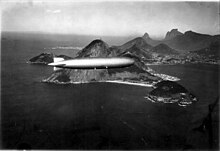LZ 127 Graf Zeppelin
The Graf Zeppelin (LZ 127) was a large German airship, or more specifically, a rigid airship from the early 20th century. It was the first airship to bear the name Graf Zeppelin (“Count Zeppelin”), as the second would be the Graf Zeppelin LZ 130. The airship made 600 trips, flying over the Atlantic 150 times and a regular cargo and mail line was established in 1936 with South America.
In 1940, it was scrapped for fighter aircraft parts.
History
It was named in homage to the German air navigation pioneer Ferdinand von Zeppelin, who rose to the rank of "Graf" or "Count" in the German nobility (according to German usage the particle "von" in the name is omitted when used a title like "Graf"). It first flew on 18 September 1928 and was the largest airship of its time, with a total length of 236.6 m and a volume of 105,000 m³. It was powered by 5 Maybach 550 hp engines and could carry a load of 60 tons.
On August 29, 1929, commanded by Hugo Eckener, it completed its first round-the-world flight, landing in Lakehurst, New Jersey, United States. His journey lasted 21 days, during which he covered 34,600 km. He left Lakehurst, crossing the Atlantic, made his first stop in the German city of Friedrichshafen, after crossing Europe, he flew over the Urals and through Siberia until he reached Tokyo where he stopped. Later he crossed the Pacific towards the United States, on August 26, after 79 hours and 22 minutes of navigation, he landed in Los Angeles, California. Finally on August 29 he returned to Lakehurst, his starting point.
The LZ 127 broke the flight record without touching down, setting it at 128 hours.
The Polar Flight
The ship managed to carry out another spectacular mission in July 1931, with a research trip to the Arctic, a trip that had already been a dream of Count Zeppelin twenty years before and that he could not fulfill due to the start of the First World War.
In July 1930, Hugo Eckener had already flown the Graf on a three-day flight from Norway to the Spitsbergen archipelago, in order to determine how the airship behaved in this region. Shortly thereafter, Eckener made a three-day flight to Iceland, completing both trips without technical problems.
The initial idea was very propaganda and spectacular, and consisted of meeting the submarine Nautilus (ex USS O-12) at the North Pole, with which they would exchange mail. The Nautilus, Australian explorer George Hubert Wilkins' submarine, was attempting to cross the Pole under the ice, though the plan was abandoned when the submarine encountered recurring technical problems, which led to its eventual sinking. in the Bergenfjord.
Eckener then planned a rendezvous with a surface ship. He intended to finance the flight by carrying mail on the ship. After publicizing this flight, around fifty thousand letters were collected around the world, with a total weight of about 300 kg. The rendezvous with the Russian icebreaker Malygin, in which the Italian pilot and polar explorer Umberto Nobile was a guest, required another 120 kg of mail. The main expenses of the expedition were covered solely by the sale of postage stamps. The rest of the funding came from Aeroarctic and the publisher Ullstein-Verlag in exchange for exclusive reporting rights. For this, Arthur Koestler was sent on board as the only journalist, at the time scientific editor of a publication of said editorial. Koestler left an account of the expedition in the last chapters of his autobiography Arrow in the Blue.
The polar flight of 1931 lasted four and a half days, from 8 a.m. on July 26 to 6 p.m. on the 30th. The Graf traveled about 10,600 km, the longest stretch without resupply being 8,600 km. The average speed was 88 km/h.
The route of this polar trip was as follows:
- Friedrichshafen — Berlin: 600 km in 8 hours (75 km/h);
- Berlin — Leningrad: 1,400 km in 16 hours (87 km/h);
- Leningrad — Kanin peninsula: 1,300 km in 12 hours (108 km/h);
- Kanín — Land of Francisco José: 1,200 km in 18 hours (67 km/h);
- Land of Francisco José — Taimyr Peninsula — New Zembla: 2,400 km in 32 hours (75 km/h);
- New Zembla — Leningrad: 2,300 km in 25 hours (92 km/h);
- Leningrad — Berlin: 1,400 km in 13 hours (108 km/h);
- Berlin — Friedrichshafen: 600 km in 8 hours (75 km/h).
The objectives of the trip were:
- Perform a Graf Zeppelin test under Arctic conditions.
- Scientific and geographical research of large areas of the Arctic, in particular:
- Measurement of magnetic field changes;
- Weather measurements (including meteorological balloon launches);
- Photo geo-registration of large areas with a panoramic camera (exploration that would take years if it were made from a boat or land)
All the participants were satisfied after the trip: the airship had proven its usefulness in the Arctic.
Technical specifications of the airship
- Triple: 40.
- Capacity: 20 passengers.
- Length: 236,53 m.
- Diameter: 30,48 m.
- Volume: 105,000 m3.
- Effective suspension: 60,000 kg.
- Motors: 5 Maybach VL-2 of 12 cylinders and 410 kW (550 hp) each.
- Maximum speed: 128 km/h.
Contenido relacionado
Politics and government of Saint Lucia
Franc (currency)
Electrical isolation



